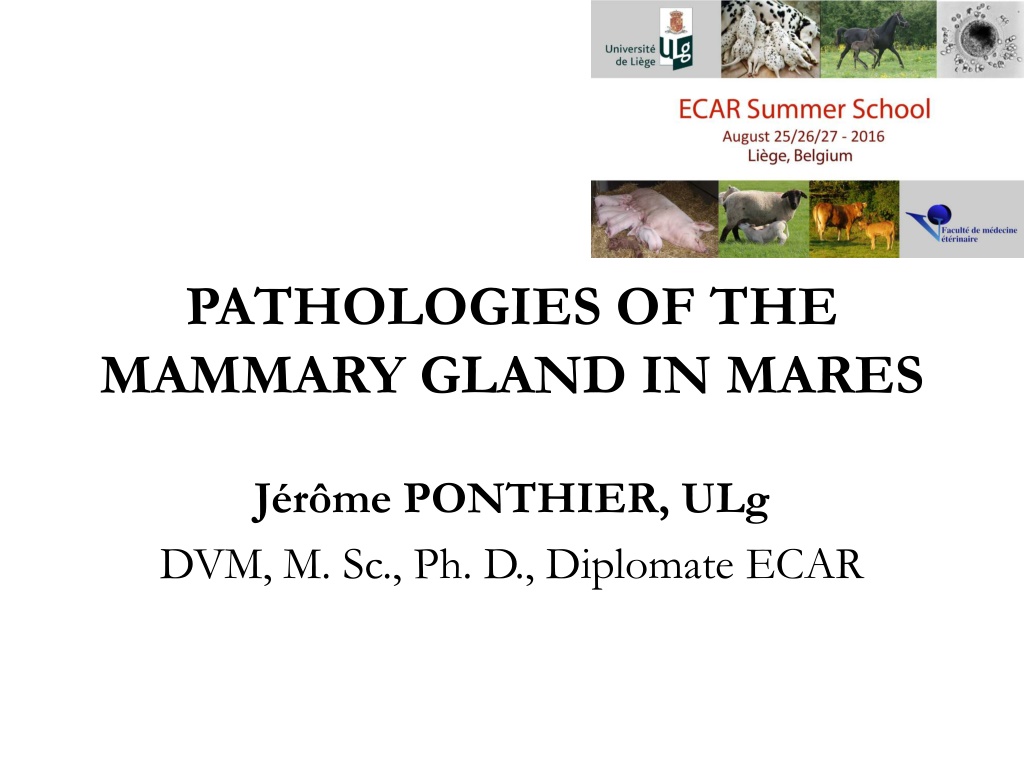Mammary Gland Pathologies in Mares: Overview & Treatment
This detailed guide explores various pathologies of the mammary gland in mares, including galactorrhea, mastitis, agalactia, and lactation induction. It covers causes, clinical signs, diagnosis, and treatment options for each condition, providing valuable insights for equine healthcare professionals.
Download Presentation

Please find below an Image/Link to download the presentation.
The content on the website is provided AS IS for your information and personal use only. It may not be sold, licensed, or shared on other websites without obtaining consent from the author.If you encounter any issues during the download, it is possible that the publisher has removed the file from their server.
You are allowed to download the files provided on this website for personal or commercial use, subject to the condition that they are used lawfully. All files are the property of their respective owners.
The content on the website is provided AS IS for your information and personal use only. It may not be sold, licensed, or shared on other websites without obtaining consent from the author.
E N D
Presentation Transcript
PATHOLOGIES OF THE MAMMARY GLAND IN MARES J r me PONTHIER, ULg DVM, M. Sc., Ph. D., Diplomate ECAR
Plan 1. Galactorrhea Premature in pregnant mares Essential In neonates In adult mares 2. Mastitis 3. Agalactia 4. Lactation induction 5. Tumors
1. Galactorrhea In pregnant mares: Causes: foetal death, twin pregnancy, placentitis, placental separation, impeding abortion Sometimes: at mid-gestation & spontaneous regression Combined Thickness of the Uterus & Placenta measure by transrectal US Treatment of placentitis
1. Galactorrhea Essential (non-pregnant mares): In neonates: Witch s milk: Maternal lactogens > Foal In adult mares: End of pregnancy in mares: E2+ P4+ Prolactine + Corpus luteum + Phyto-oestrogens + endogenous prolactine Equine Cushing Disease Treatment: Diet and Drink Inhibition of Prolactine secretion (dopamine agonists) Differential diagnosis: Mastitis
2. Mastitis Clinical signs: Summer, during lactation or within 8 weeks after Also possible in non lactating mares Warm, swollen & painful udder Fever >>> anorexia, Diagnosis: Clinical Cytology of milk Mare s milk contains naturally lots of cells Bacteriology: typically, Streptococcus zooepidemicus
2. Mastitis Treatment: Local: General Frequent Milking (Foal?), hydrotherapy Intra-mammary AB (Bovine Stuffs ?) Antibiotherapy (TMP-S) NSAIDs
3. Agalactia Primiparous mares Nutritional state of the mare? Fescue grass infected with ergot alkaloid producing fungus Prolactine levels lower in mares consuming it Abortion, fetal membrane retention,
4. Lactation induction Serotonine Metergoline Inhibition Inhibition Stimulation R serpine Perh nazine Domperidone Sulpiride Bromocryptine Cabergoline Inhibition Dopamine Stimulation Inihbition Stimulation PROLACTINE Production
4. Lactation induction Foaling : d0 Adoption : d14 Sulpiride d17 d10 Progestagens d5 Oestrogens d7 d14 Milking Week 1 Week 2 Week 3
5. Tumors Real mammary glands tumor: Rare Adenoma, Carcinoma (metastasis in very rare case) Udder skin tumors: Sarcoids Melanoma (Habronema)
EqMammary: MQC1 Californian Mastitis test in equine: 1. Is used to diagnose acute post-partum mastitis 2. Is used to diagnose acute mastitis on non- lactating mare 3. Is used to diagnose subclinical mastitis 4. Is not used, because of natural cellularity of mare s milk
EqMammary: MQC1 Californian Mastitis test in equine: 1. Is used to diagnose acute post-partum mastitis 2. Is used to diagnose acute mastitis on non- lactating mare 3. Is used to diagnose subclinical mastitis 4. Is not used, because of natural cellularity of mare s milk
EqMammary: MQC2 Lactation induction in the mare is: 1. Giving colostrum at his beginning 2. Achieved after 24 hours and is helpful for neonates 3. Requiring regular milking of the mare 4. Requiring exogenous oestrogen administration
EqMammary: MQC2 Lactation induction in the mare is: 1. Giving colostrum at his beginning 2. Achieved after 24 hours and is helpful for neonates 3. Requiring regular milking of the mare 4. Requiring exogenous oestrogen administration

























